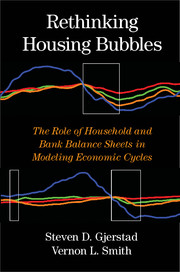 Rethinking Housing Bubbles
Rethinking Housing Bubbles Book contents
- Frontmatter
- Contents
- Acknowledgments
- 1 Economic Crises, Economic Policy, and Economic Analysis
- 2 Goods and Services Markets versus Asset Markets
- 3 Asset Performance
- 4 The Great Depression
- 5 The Postwar Recessions
- 6 What May Have Triggered or Sustained the Housing Bubble (1997–2006)?
- 7 The Bubble Bursts
- 8 Blindsided Experts
- 9 What Might Be Done?
- 10 Learning from Foreign Economic Crises
- 11 Summary: What Have We Learned?
- Index
- References
10 - Learning from Foreign Economic Crises
Consequences, Responses, and Policies
Published online by Cambridge University Press: 05 June 2014
- Frontmatter
- Contents
- Acknowledgments
- 1 Economic Crises, Economic Policy, and Economic Analysis
- 2 Goods and Services Markets versus Asset Markets
- 3 Asset Performance
- 4 The Great Depression
- 5 The Postwar Recessions
- 6 What May Have Triggered or Sustained the Housing Bubble (1997–2006)?
- 7 The Bubble Bursts
- 8 Blindsided Experts
- 9 What Might Be Done?
- 10 Learning from Foreign Economic Crises
- 11 Summary: What Have We Learned?
- Index
- References
Summary
So, any interesting model must be a dynamic stochastic general equilibrium [DSGE] model. From this perspective, there is no other game in town. …If you have an interesting and a coherent story to tell, you can do so within a DSGE model. If you cannot, it probably is incoherent.
… [T]he models are not well suited to analyze extremely rare events.
– V. V. Chari, Testimony before the Committee on Science and Technology, U.S. House of Representatives, July 20, 2010All of the papers employ simple applied dynamic general equilibrium models … to decompose changes in output into three portions: one due to changes in inputs of labor, another due to changes in inputs of capital, and the third due to the changes in efficiency with which these factors are used.
–Timothy J. Kehoe and Edward C. Prescott, from the introduction to Great Depressions of the Twentieth CenturyIntroduction and Overview
Our overriding objective in this book has been to show that unusual credit flows frequently produce asset bubbles; when those assets are highly leveraged, immobile, and illiquid, borrowers and the financial system often suffer severe balance sheet deterioration in a collapse. Moreover, the economy is left saturated with an excess of produced assets, so that output is reduced. We have described the Great Recession as the result of a balance sheet crisis. In this chapter, we examine several even more severe downturns and show that all resulted from a collapse in the production of fixed assets. The opening quotes for this chapter argue for the view that the source of severe economic downturns lies in reductions to inputs of labor and capital and a reduction in the efficiency of these factors of production. Although this view is not “the only game in town,” it is arguably the dominant view in macroeconomics. In this book, we have sought to present evidence that supports an alternative view. Our argument is that when a bubble has pushed asset prices above fundamental value, production of those assets grows rapidly, but when asset prices become noticeably disconnected from fundamentals, financing for purchases of those assets collapses, asset prices collapse, and their production collapses too. When that happens, the economic downturn can be severe. The economic collapse does have noticeable effects on inputs of labor and capital and their efficiency, but changes to those factors are not causal.
- Type
- Chapter
- Information
- Rethinking Housing BubblesThe Role of Household and Bank Balance Sheets in Modeling Economic Cycles, pp. 251 - 267Publisher: Cambridge University PressPrint publication year: 2014


